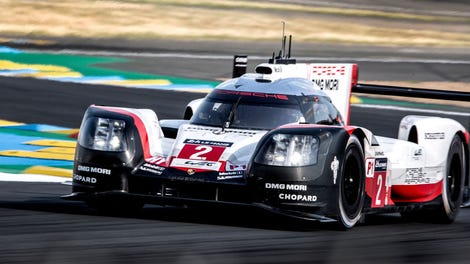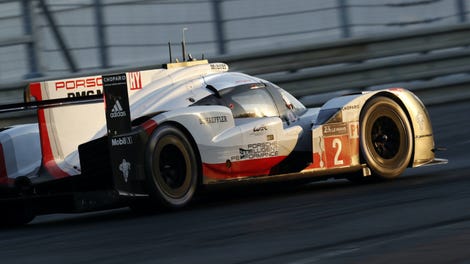
For the past few years, racing fans who tuned in to the FIA World Endurance Championship could watch Porsche, Audi and Toyota duke it out in the series’ top LMP1 class—a class that featured the most advanced race cars in the world going at it in the 24 Hours of Le Mans and some of the best tracks on Earth.
But Audi is out, and as of Friday, Porsche is too, all for the much lesser electric open-wheel series that is the FIA Formula E Championship.
Much of it is a symptom of the growing costs of running a Le Mans Prototype 1 race car, which is in line with what some Formula One teams spend. For manufacturer after manufacturer, these costs have been too great to justify in the face of Formula E’s cheap, media-friendly alternative.
Formula E is just a few years younger than WEC, which started in 2012. But the choice for manufacturers is simple, with Formula E’s lower-cost setup offering companies a testing ground for electric cars, a step above LMP1’s permitted hybrids in terms of future technology. This recent all-electric exodus is also forebodingly similar to what happened to WEC’s predecessor, which died a bleak and self-imposed death in the 1990s partially due to letting costs get out of control.
Advertisement
A year or two ago, this seemed all but implausible. When rumors came Thursday that Porsche would end its dominant program in LMP1, we were left to wait and sweat it out. As one of only two manufacturer-backed teams left in the LMP1 division, a Porsche withdrawal would have devastating impacts on the series and could even kill its top class altogether.
But we didn’t have to wait long. On Friday, it was official. Porsche, winner of the last three 24 Hours of Le Mans even after falling to 56th place at one point this year, would end its World Endurance Championship LMP1 efforts at the end of 2017and leave Toyota as the lone manufacturer left in that category.
This exodus is all thanks to LMP1’s crippling costs, but you also need to look at the class’ resulting lack of competition, and its struggle to provide relevancy to the most cutting-edge tech in road cars.
LMP1 Costs Are Astronomical
Peugeot is an excellent example of how cost is what’s choking the top class of the world’s premier endurance-racing series. Peugeot, rumored to return to LMP1 around 2016, had interest in WEC’s top class even for its inaugural 2012 season. But each time it’s tried, the financial commitment has been too much.
Advertisement
Peugeot had been one of the top teams in LMP1’s diesel era from the mid-2000s until 2012, when the company pulled out of its World Endurance Championship effort just two months before the season began. Europe was in a financial crisis at the time and Peugeot was on the ropes, as it had bet big on midsize sedans—just about the worst-performing kind of car in recent years. Autosport cited a company statement as saying the withdrawal was due to hard economic times and a focus on turning around declining car sales.
Peugeot has been healthier as of late, with sales back up and the economic crisis resolved, but they took one look at LMP1’s huge hybrid-era costs and passed, as Sportscar365reported last year:
Speaking to Endurance-Info, Peugeot Sport director Bruno Famin said the escalating costs to compete in the premier class of the FIA World Endurance Championship currently has the French manufacturer not being able to commit to such a program.
“The budget is [the problem],” Famin told Endurance-Info. “The President of PSA dreams of a return of Peugeot to the 24 Hours of Le Mans and more generally, in endurance [racing].
“But for this there are conditions… That PSA gets better, which is pretty much engaged and that the requested budget is sharply down.
“Currently it’s just an idea and a target on the horizon.”
Peugeot, which ran factory 908s in Le Mans-labeled series from 2007-2011, pulled the plug on its program just weeks prior to the inaugural round of the WEC in 2012 due to company wide financial issues.
Famin called out other companies spending ridiculous amounts of money, and hinted that Peugeot would love to go back to endurance racing once the financial commitment needed to compete returned to something sane. From Sportscar365:
However, with Audi and Porsche repordidely spending in excess of $200 million annually, and Toyota having recently increased its 2016 budget to nearly $100 million, Famin said Peugeot would be unable to compete with those numbers.
“The FIA WEC is a magnificent championship with beautiful cars,” Famin said. “The series is ideal for manufacturers and is much better than F1.
“The technology is interesting as well as the format. Manufacturers fight with [each other] and we remember the manufacturers as winners more than drivers, with a few exceptions.
“The big reservation concerns the budget, which is currently far too high. We can only praise the approach of the FIA and ACO to reduce costs. …
“Peugeot will return to endurance racing the day it will be possible to mount a real project with something behind it.”
We’ve seen those numbers before. Audi’s LMP1-Hybrid efforts were estimated at nearly $250 million a year, as Porsche’s are rumored to hover at over $200 million; news website Sportscar365 estimates Toyota’s to be around $100 million annually.
As a bit of comparison, Ferrari competed in F1 on an annual budget of $470 million in 2013 including hospitality, NBC Sports reports, making it the highest spender for that season. But the smallest F1 team, CNN reports, runs on a yearly estimated budget of $44 million. The top Verizon IndyCar Series team ran on $15 million in 2013.
With costs nearing F1 levels and more relevant racing series out there, an LMP1 exit makes sense. It isn’t fun to hear about, but it makes sense.
Formula E Is Hilariously Cheap By Contrast
Formula E’s annual budget is far below even IndyCar, with CNN reporting that teams had a $3.5-million annual spending cap in 2016. For the fifth, sixth and seventh seasons of Formula E, which span from 2018 through 2021 since the series runs from the fall of one year to the summer of the next, FIA regulations mandate that the price of any race car should not exceed 800,000 euros.
That’s $945,000 at current exchange rates, which is less than 1 percent of what Ferrari spent on research, development and manufacturing of its F1 car in 2013. The $945,000 figure is the max price for the Formula E car, ready to race and powertrain included.
The World Endurance Championship did make an effort to keep costs down with some changes to aero, staffing and testing-day restrictions in 2016. But the “down” part wasn’t exactly about making the series less costly than it already was. It was to keep prices from climbing even higher.
Advertisement
But keeping costs from getting even higher wasn’t enough, at least to keep Porsche or Audi around. By dumping the spaceship-looking LMP1 cars and moving into Formula E, Porsche will effectively save a solid $200 million a year while also testing its full-electric technology in race conditions.
Formula E Also Offers Something LMP1 Can’t: Competition
Over the five years that the World Endurance Championship has run, the four main manufacturer efforts have been from Audi, Toyota, Porsche and Nissan. Only one remains. Here’s when and why the others quit:
- Nissan: The team competed in WEC in 2015, but Autosport reports that the team withdrew shortly before the 2016 season began due to development issues. The race car had just gone through a complete redesign, and Nissan hadn’t begun manufacturing yet. LMP1 project boss Mike Carcamo told the website that it didn’t make sense to test and develop during race season, and that the team would prefer to focus where it could be successful.
- Audi: The manufacturer left WEC after the 2016 race season, strapped with Dieselgate burdens and on its way to compete in Formula E.
- Porsche: The company will leave WEC after this race season, heading up a Formula E effort and leaving Toyota as the only remaining manufacturer in LMP1 at the time being.
With the LMP1 class down to one committed manufacturer after this season, there isn’t much of a reason to stick around—for fans or for teams. If there’s no one to compete with, spectators have no measure of how your cars stack up against anyone else’s.
Advertisement
The fewer teams you compete against, the less your triumphs mean. After Audi’s 2016 exit, the LMP1 class was down to just two teams, Toyota and Porsche. That couldn’t have given Porsche too much incentive to keep at it.
(Also, if you’re wondering which manufacturer was the last to run a factory-backed prototype car after the fall of the WSC in the early ‘90s, yep, it was Toyota.)
That makes LMP1 an expensive endeavor that doesn’t have a big payoff in terms of competition and showing what a car can do. Meanwhile, Formula E is dense with manufacturers—both existing and incoming.
Electric Racing Is A Testing Ground For Street Cars, Which Is What Le Mans Used To Be
Before Porsche’s exit, the World Endurance Championship made an even harder push to transform its top class into a testing ground for new technology in its manufacturers’ street cars. The LMP1 class integrated hybrids into competition, and Le Mans begged Porsche, which already runs hybrids, to stay just last month by mandating plug-in hybrids for LMP1 class in 2020.
Advertisement
Now, we’re trying to find out if LMP1 will make it to 2020.
That’s for good reason, too. It doesn’t make sense to shovel out hundreds of millions a year to compete in cars that fall on the middle step of the gas-electric ladder, when, in reality, the automotive industry is moving to electric power in the near future and electric racing can be had for a tiny, tiny fraction of the cost.
Formula E gives companies a place to test their electric road technology, which is what’s appealing right now. With the early 2020s as the target date for a lot of manufacturers to start pumping out electric, autonomous vehicles on a regular basis, testing this stuff in harsh racing conditions is important.
Advertisement
The planned support series for Formula E, expected to come around in the next few years, will be electric and autonomous. That’s even more useful to test in.
For instance, rumors last year were that BMW was looking at entering an LMP1 program just like Peugeot. But BMW went to Formula E instead, for relevance purposes. Autosport reports that motorsport boss Jens Marquardt said the focus on hybrids didn’t mesh with the company’s focus on the electric BMW i brand, and that the current LMP1 rulebook “does not fulfill [BMW’s] needed criteria.”
But while BMW was still thinking about WEC, its budget was huge. BMW had a proposal with a rumored $450 million first-year and developmental budget, which is just $20 million short of Ferrari’s F1 budget mentioned earlier. That’s a ton of money for a series that isn’t a household name like F1 across the ocean.
Advertisement
BMW’s board shot down that costly proposal, and announced earlier in July that it would be joining Formula E for the 2018-2019 race season.
(As an aside, this problem is reverberating across the motorsports world. BMW’s rival Mercedes recently skipped out of its position in Germany’s legendary touring car series DTM for Formula E.)
With emissions crackdowns and one Dieselgate scandal after another among companies, it really only makes sense to go electric—on roads and in series that promote development. (Things like NASCAR, for example, have almost entirely moved past the “testing grounds” phase of their life cycles. Modern NASCAR is here for entertainment, not necessarily to test the latest V8 gasoline engines.)
That’s not to say Formula E has it all figured out and will be the next big thing in racing. Despite attracting a lot of car companies with low costs and promises of battle grounds to compete with the latest electric technologies, the series still has to get fans in seats and tuned in on television—without large eruptions of laughter, which is actually a problem Formula E has, ideally.
In order for these moves to be worthwhile from an exposure standpoint for the companies that have mad the commitment, Formula E as a series has a lot to improve on. That goes further than the financial side, which isn’t great: In its inaugural 2014-2015 season, Formula E lost $68.4 million.
Advertisement
But, regardless, it’s going to have cars in the field for a new and novel racing series. That’s a start. WEC, on the other hand, keeps making the mistakes that Le Mans racing has in the past.
Repeating The Same Mistakes
The World Endurance Championship has been around since 2012, which sounds young. But its roots are much older than that, and WEC filled a void in auto racing when it came around five years ago. The void it filled, grimly, was left by the demise of the World Sportscar Championship in the early ‘90s.
Advertisement
The World Sportscar Championship ran under various series names and sets of regulations from 1953 through 1992, when the tech mandated on the race cars almost exactly matched that of F1. Budgets did, too. Teams realized that what they were spending on the WSC could get them an entry in F1, which had much better publicity and TV coverage.
So, teams went to Formula One instead. F1 had a lot more opportunity for exposure, and the costs to field a team—around $15 million in the late 1980s and early 1990s—were virtually the same in both. When the payoff is better in a rival series, teams leave.
For WEC, things are beginning to look a lot like they did two decades ago: not good. Prices are out of control, and the alternatives, like Formula E, are simply better, cheaper and come with the same or more exposure.
Advertisement
If WEC continues to repeat the mistakes of its predecessor, the series could end up just like it: long dead, leaving only the reminiscence of worldwide endurance racing behind. Repeating the same mistakes is no way to go through life, and it’s no way to run a successful racing series, either.


















